#southern pig–footed bandicoot
Text
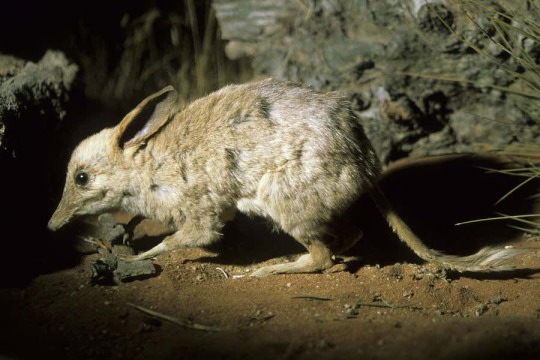
Chaeropus ecaudatus the Southern Pig–footed Bandicoot
Pig–footed bandicoots (genus Chaeropus) were so called because of their hooflike forefeet. They had relatively slender legs compared to other bandicoots, allowing them to move quickly through the landscape.
Although initially designated as a single species, Chaeropus yirratji was split from C. ecaudatus in 2019 on the basis of morphological differences. Both species became extinct by the 1950s due to habitat loss from land clearing for agriculture and predation from cats and foxes.
#southern pig–footed bandicoot#animals#australian animals#mammals#australian mammals#marsupials#australian marsupials#bandicoots#pig–footed bandicoot#s o: australidelphia#o: peramelemorphia#f: chaeropidae#g: chaeropus#sp: c. ecaudatus
32 notes
·
View notes
Text
Crash bandicoot 5

They are easily broken to reveal small pieces of insects and soil. They are 25-50 mm long and 8 mm in diameter. Southern brown bandicoot scats (poo) are firm and cylindrical with a smooth, mud-like surface.
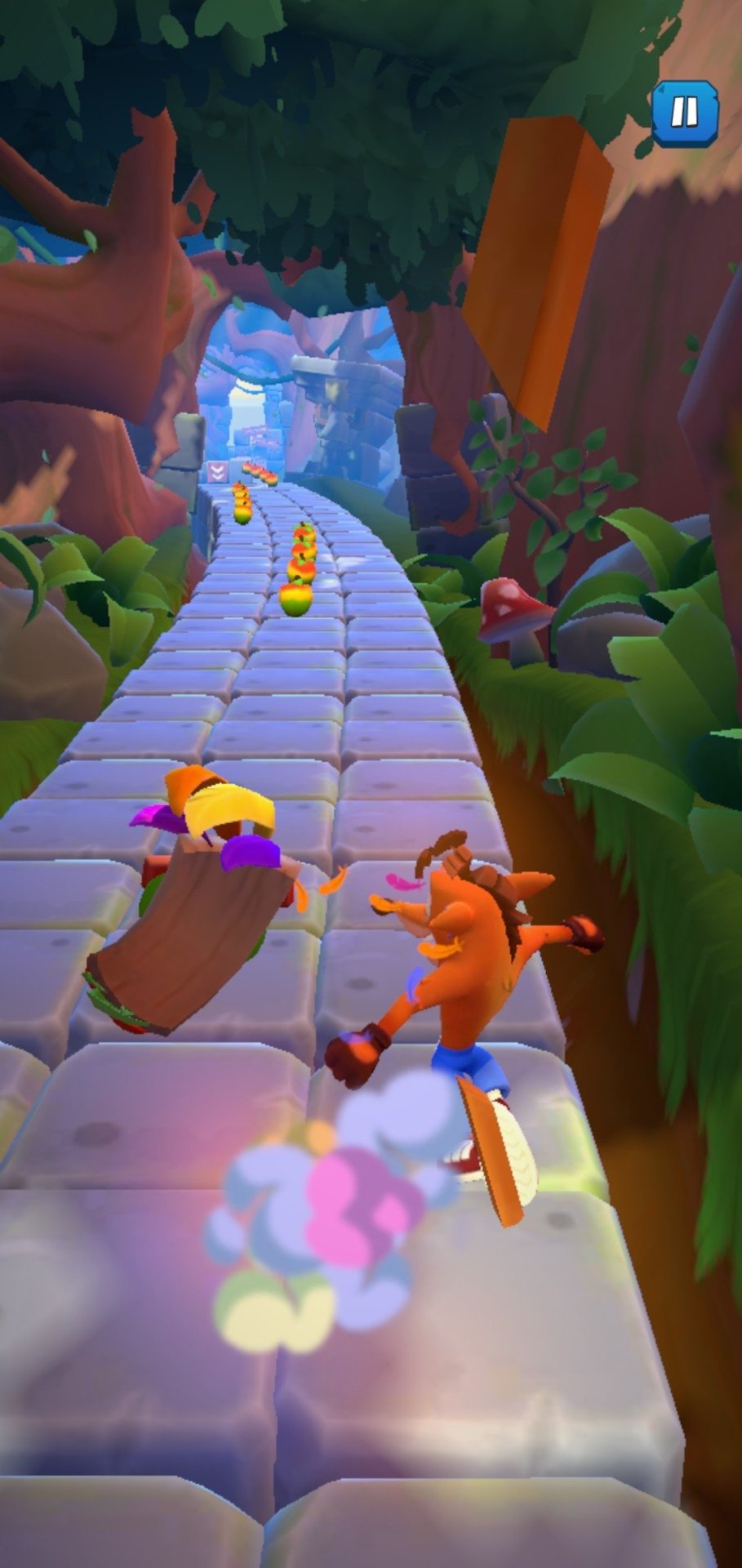
… Names in order: pig-footed bandicoot, short-nosed bandicoot, rabbit-eared bandicoot. It has hind feet with fused toes like those of a kangaroo. It has a sharp, pointed nose with rodent-like teeth. The bandicoot is a rabbit-sized marsupial that gets its name because it resembles both a rat and a pig. According to SuperData Research, the 3D platformer sold 402,000 digital units. Unlike Watch Dogs: Legion which broke franchise records with its digital sales in October, Activision’s Crash Bandicoot 4: It’s About Time saw slightly less success. The supposed release date is some time in November 2021, and it will be released to PS5, Xbox Series X, Switch, PS4, Xbox One, and PC. … All of these can be used to solve puzzles that the game will give us. Inspired by the Los Angeles underground dance music scene of the early ’90s, Pasquale founded Insomniac in 1993.Ī game named Spyro 4: Wings of Fury will be announced at the upcoming SGF. Over the last 25 years, Pasquale Rotella has been known as many things. Who owns Insomniac records?Įxperience creator, businessman, philanthropist, film producer, and night owl. … In 2013, Insomniac entered into a creative partnership with Live Nation. Insomniac is an American electronic music event promoter and music distributor. PlayStation Studios Does Live Nation own insomniac? It is home of six levels and two boss fights. He is a witch doctor spirit living inside a wooden mask who guides Crash, his sister Coco and their friends as they defeat the forces of evil. What is the name of the mask in Crash Bandicoot?Īku Aku is the deuteragonist of the Crash Bandicoot series. Catching the Golden Wumpa will add 200 Wumpa Coins once you finish the race.

Your goal is to chase after and catch them, either by touching it or hitting it with a weapon. Smash it, and a Golden Wumpa Fruit will spawn and shoot up the track. It’s everywhere, and it even has its own drink. It’s the Xbox 360 title that has become the fastest-selling game ever in the US and already made developer Bungie a cool $300 million. Why does Crash Bandicoot look different in Japan?īungie’s shooter grabs the top slot in the Japanese charts, 360 sales also see spike in the region. Sane Movie was released on Januin 2D, 3D, RealD 3D, Dolby Cinema, and IMAX by Universal Pictures in the United States and by Sony Pictures Releasing under Columbia Pictures in other countries. Sanity Island, also known as North Sanity Island and Jungle Island in some documents during the early development of the original game, is the first and most recurring of the three islands, being the home of Crash Bandicoot and his companions (until Crash of the Titans). Just as her older brother, she was genetically engineered through the use of Doctor Neo Cortex’s and Doctor Nitrus Brio’s Evolvo-Ray. Is Coco Crash Bandicoot’s sister?Ĭoco Bandicoot is the younger sister of Crash Bandicoot. “The sound Aku Aku makes is gibberish and was never intended to mean anything,” Dave Baggett, Naughty Dog employee who wrote code for the series, said on a Quora thread. As it turns out, it meant absolutely nothing. Your first guess might be something along the lines of “ ABOOGABOOGA” or “HOLBOGA”. Despite all the rumors and speculation and the hints and the hopes, it doesn’t matter.

Not by any developer - not even Activision- for years to come. A new Crash Bandicoot title will not happen, in any form, anytime soon. After Crash Bash, the exclusivity with Sony ended and Universal made Crash multiplatform with Wrath of Cortex. Sony bought them out and Naughty Dog went on to create Jak & Daxter for Sony. Recent releases were developed by Vicarious Visions and Toys for Bob.Why did Sony sell Crash Bandicoot?Īfter Crash Team Racing, Naughty Dog moved on in order to develop games without being subject to Universal’s constraints. Naughty Dog developed the series between 19. Following a merger in 2007, Activision owns the IP. Who owns the rights of Crash Bandicoot?Ĭrash Bandicoot was originally produced by Universal Interactive, which later became Vivendi Games. Is Crash Bandicoot owned by Nintendo?Ĭrash Bandicoot is now owned by Activision since 2007 and Vicarious Visions currently makes the games. The series was originally produced by Universal Interactive, which later became known as Vivendi Games in 2007, Vivendi merged with Activision, which currently owns and publishes the franchise. You are watching: Who Owns Crash Bandicoot? In Who Owns Crash Bandicoot?

0 notes
Text
†Pig-footed Bandicoots (Chaeropus)
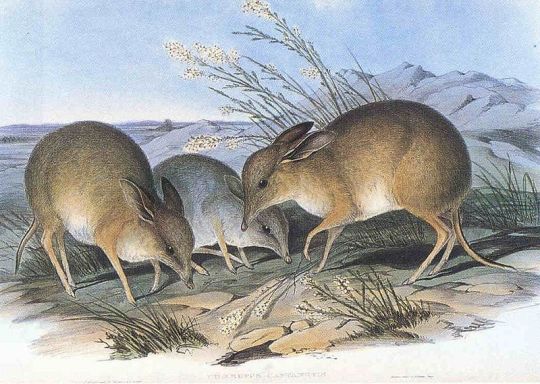
Pig-footed bandicoots were recently considered separate to all other bandicoots. Two similar species are recognized, varying in historical ranges and morphology of dentition and feet. Their fur ranged from uniform grey-brown to russet and fawn tones, helping them camouflage into arid sandy desert and grassland. From 32 to 40cms long, they measured up similarly to a small rabbit.
Chaeropus, uniquely, had feet like tiny hooves. They walked on only two functional toes of the forefeet, and one toe of the hind-foot, the rest being vestigial. They were known to run very fast, with a quick bounding gait. Though reported to eat insects, it’s thought they were largely herbivorous.
The Southern pig-footed bandicoot, C. ecaudatus, occurred through desert shrub-lands in the lower part of South Australia extending into Western Australia. C. yirratji, the Northern pig-footed bandicoot, inhabited grassland and sandy desert in central Australia and WA.
Both species were never prolific according to Indigenous oral tradition. However, they were in serious decline by the 19th century and were extinct less than 150 years after European description. Foxes were not yet established in their ranges, and though some cats were, the cessation of thousands of years traditional burning practices is thought to have been the major contributor to their extinction. Burning provided a patchwork of new growth on which to feed alongside recovered zones of shelter. Introduction of sheep and cattle also changed the landscape dramatically, further decimating crucial food sources of native animals.
#Chaeropus#pig-footed bandicoot#Chaeropodidae#Southern pig-footed bandicoot#Northern pig-footed bandicoot#Chaeropus ecaudatus#Chaeropus yirratji#Peramelemorphia#marsupials#australian animals#australian wildlife#Australidelphia#extinction
57 notes
·
View notes
Text
Multiple new cryptic species of bilby, and a case of mistaken identity among bandicoots leading to an accidental introduction:
Even after the catastrophic debacle of introducing non-native cane toads, European rabbits, foxes, dromedary camels, feral cats, and invasive invertebrates, Australian settler institutions are cursed with mistakes which unleash invasive animals even when attempting the well-meaning reintroduction of native species.
Some new research from 2018 revealed an alarming mistake in ecological management. Basically, you’ve got this cute little bilby from the remote far western coast near Shark Bay which was transported by scientists thousands of kilometers and now has a big strong population just chilling near Adelaide. Bilbies, or bandicoots, are understood to be important to maintaining healthy soils, especially in Mediterranean chaparral zone and the other climatically mild and temperate regions of the coast of southern Australia (ranging between Perth through Adelaide to the Melbourne area, and including Tasmania), so there is popular celebration of the reintroduction of bandicoots to environments which they historically inhabited before European agriculture and invasive species led to local extinction of many bandicoots. The western barred bandicoot (Perameles bougainville) went extinct across almost all of its range and disappeared from native habitats on the mainland after European invasion, but a few populations survived on extremely remote islands off the coast of Shark Bay in on the far western coast of Western Australia. Intending to help rehabilitate native soils and plant communities, Australian settler ecologists then took some bandicoots from Shark Bay islands and “reintroduced” the western barred bandicoot over 3000 kilometers away at the Arid Recovery Reserve, near Lake Torrens area north of Adelaide. This was done because settler scientists thought that this bandicoot species had historically lived across much of southern Australia. Uh oh: It turns out that this western barred bandicoot lineage was historically only native to a small portion of the western coast of Australia near Shark Bay far, far away and was never native to the Adelaide or Lake Torrens area, because what was assumed to be the “western barred bandicoot” was actually 5 different cryptic species. 4 of these species are now extinct. The only living member of this bandicoot lineage remains only at Shark Bay. But now, these Shark Bay bandicoots are living north of Adelaide, where a couple thousand of them live at Arid Recovery Reserve.

A western barred bandicoot from the coastal Western Australia population at the islands of Bernier and Dorre:

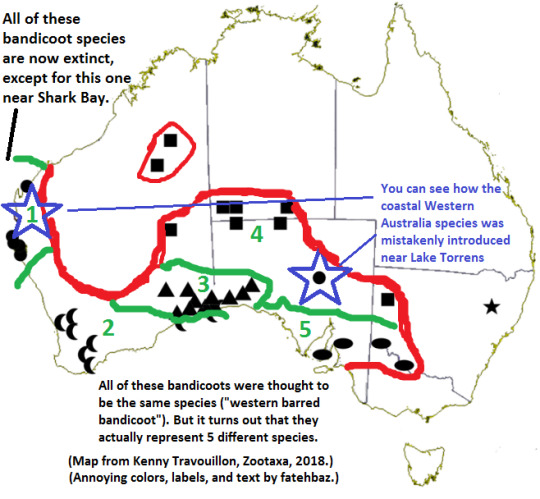
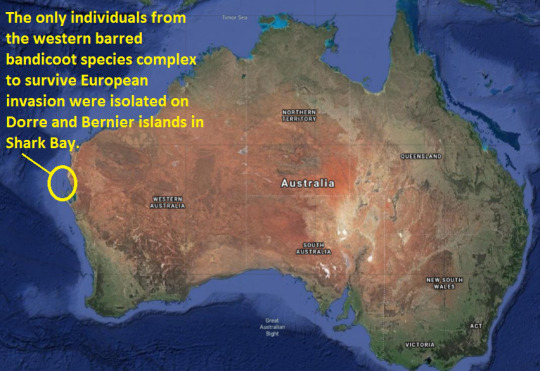
Kenny Travouillon, the lead researcher who reported the cryptic species and new understanding of bandicoot biodiversity, was featured recently in this report from Western Australian Museum, February 2018:

“For example, many people will have seen the Quenda (Isoodon obesulus fusciventer), a bandicoot familiar to Perth backyards. For more than 150 years the Quenda had been thought to be a subspecies of the Southern Brown Bandicoot (Isoodon obesulus) from the east coast of Australia, when in fact our research shows that it is a distinct species and more closely related to the Golden Bandicoot (Isoodon auratus) endemic to WA and found on Barrow Island and throughout the Kimberley.”
“We also re-evaluated the Western Barred Bandicoot (Perameles bougainville), a species now only found on islands near Shark Bay, and we found that it is in fact a complex of five distinct species. Four of these species had been named in the 1800s, but we described a new species from the Nullarbor region, the Butterfly Bandicoot or Nullarbor Barred Bandicoot (Perameles papillon). This is a new species that went extinct between 1920 and 1960, as a result of feral carnivores spreading west,” he said.
Four of the eight bandicoots that once lived in in WA are now extinct: the Pig-footed Bandicoot (Chaeropus ecaudatus), the Desert Bandicoot (Perameles eremiana), the Marl Bandicoot (Perameles myosuros) and the Butterfly Bandicoot (Perameles papillon). The four that remain are the Quenda (Isoodon fusciventer, previously known as the Southern Brown Bandicoot), Northern Brown Bandicoot (Isoodon macrourus), Golden Bandicoot (Isoodon auratus), and the Little Marl (Perameles bougainville), which was previously known as the Western Barred Bandicoot. [End of excerpt.]
Here’s a story on how the confusion has resulted in a non-native bandicoot species being reintroduced where it didn’t belong:


An endangered Australian bandicoot that was reintroduced to the Australian mainland is now believed to be one of five distinct species, and researchers say it may have been a mistake to introduce it to South Australia.
Scientists working for the Western Australian Museum have published research that concludes that what has been known as the western barred bandicoot is in fact five distinct species – four of which had become extinct by the 1940s as a result of agriculture and introduced predators. The species were closely related but occurred in different parts of Australia.
In the 2000s, western barred bandicoots that had survived on the arid Bernier and Dorre islands off Western Australia were reintroduced to the mainland, including to a predator-proof reserve in outback South Australia. But the new study shows the surviving species that was translocated to that part of the country would never have occurred there previously. Lead researcher Dr Kenny Travouillon made the findings after analysing skulls and DNA from tissue from specimens held in collections in Paris and London.He said the research, which was published in Zootaxa, came to the conclusion that the western barred bandicoot was the only remaining species of the five.
The species that has been reintroduced around Australia would have originally occurred only in parts of Western Australia. “On the mainland, that species should have only been in WA along the coast from Shark Bay to Onslow,” he said. “They should never have been brought to South Australia, but that decision was made from the old research.” Dr Kath Tuft, the general manager of the Arid Recovery Reserve in South Australia, said there were now as many as 2,000 western barred bandicoots at the reserve. She said what had been considered a reintroduction of the species was now technically an introduction. [End of excerpt.]
-----
Important distinction: There is another celebrated - and more successful - bandicoot reintroduction project involving a different species.
The eastern barred bandicoot (Perameles gunnii) lives on Tasmania and on the mainland in southern Victoria near Melbourne. The population that once inhabited mainland ecosystems almost went entirely extinct, but there are multiple successful reintroduction sites in Victoria and a captive breeding program.
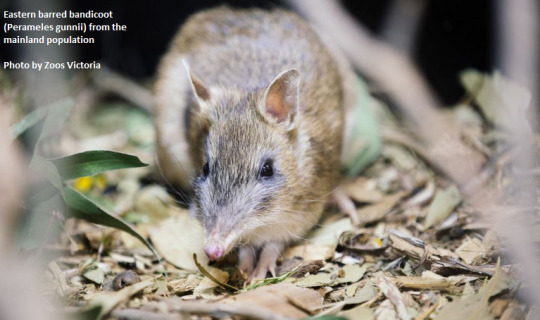
The species also lives on Tasmania, but here are the reintroduction sites on the mainland near Melbourne [map from the species recovery plan, State Government Victoria]:
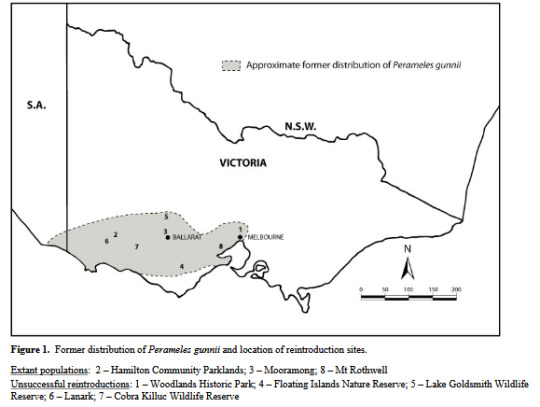
This bandicoot species does belong in mainland southern Australia.
11 notes
·
View notes